تخيل هذا: أنت ترسم خريطة قبلة الشيف لـ خطة المشروع ق، وتخطيط جميع المخرجات وتواريخ الاستحقاق والمكلفين. سير العمل ? دقيق. الجدول الزمني؟ لا تشوبه شائبة. والفريق؟ لا تشوبه شائبة. 🤩
ومع ذلك، في منتصف المشروع، يجد فريقك أن الخطة قد خرجت عن مسارها تمامًا. ولا يوجد ما يكفي من الكافيين في منطقة الولاية الثلاثية لتزويدك بالطاقة اللازمة لإنهاء المشروع في الوقت المحدد. ☕
هذا السيناريو مألوف جدًا لمديري المشاريع، الذين غالبًا ما يجدون أنفسهم يعيدون تعيين المهام، ويؤخرون المواعيد النهائية، ويعتذرون للعملاء أثناء تأخر المشروع. ما هو السبب؟ الاختناقات، أو نقطة الازدحام التي تبطئ الإنتاج.
لمساعدتك على فهم الاختناقات بشكل أفضل - وتجنبها في المشاريع المستقبلية - نتعمق في ماهيتها، وكيفية تحديدها، وكيفية منعها في شركتك.
ما هو عنق الزجاجة؟
ببساطة، عنق الزجاجة هو أي شيء يعطل خطة مشروعك أو يعرقلها أو يؤخرها.
فكّر في عنق الزجاجة حرفيًا: النقطة الضيقة أو عنق الزجاجة المصممة لإبطاء تدفق السائل. وفي نفس الصدد، فإن الاختناقات في إدارة المشاريع بمثابة نقطة تقييد - نقطة حيث يوجد الكثير من العمل الذي يجب القيام به ولا يوجد ما يكفي من الأشخاص والعمليات والأنظمة للتعامل معه. 🧐
في حين أنها تختلف من صناعة إلى أخرى، إلا أن هناك عادةً نوعان من الاختناقات:
- الاختناقات قصيرة الأجل : غالبًا ما تكون الاختناقات قصيرة الأجل ناتجة عن نقص في العمالة وهي مشاكل مؤقتة. على سبيل المثال، قد يعاني متجر متعدد الأقسام من اختناقات خلال شهر ديسمبر مع زيادة المتسوقين في العطلات
- الاختناقات طويلة الأجل: تمتد الاختناقات طويلة الأجل لفترة طويلة من الزمن، حيث تكون الأنظمة أو العمليات غير الفعالة هي السبب الجذري. على سبيل المثال، الوكالة الإعلانية التي لا تستثمر في نظام فعالبرنامج فعال لإدارة المشاريع ستواجه اختناقًا طويل الأجل
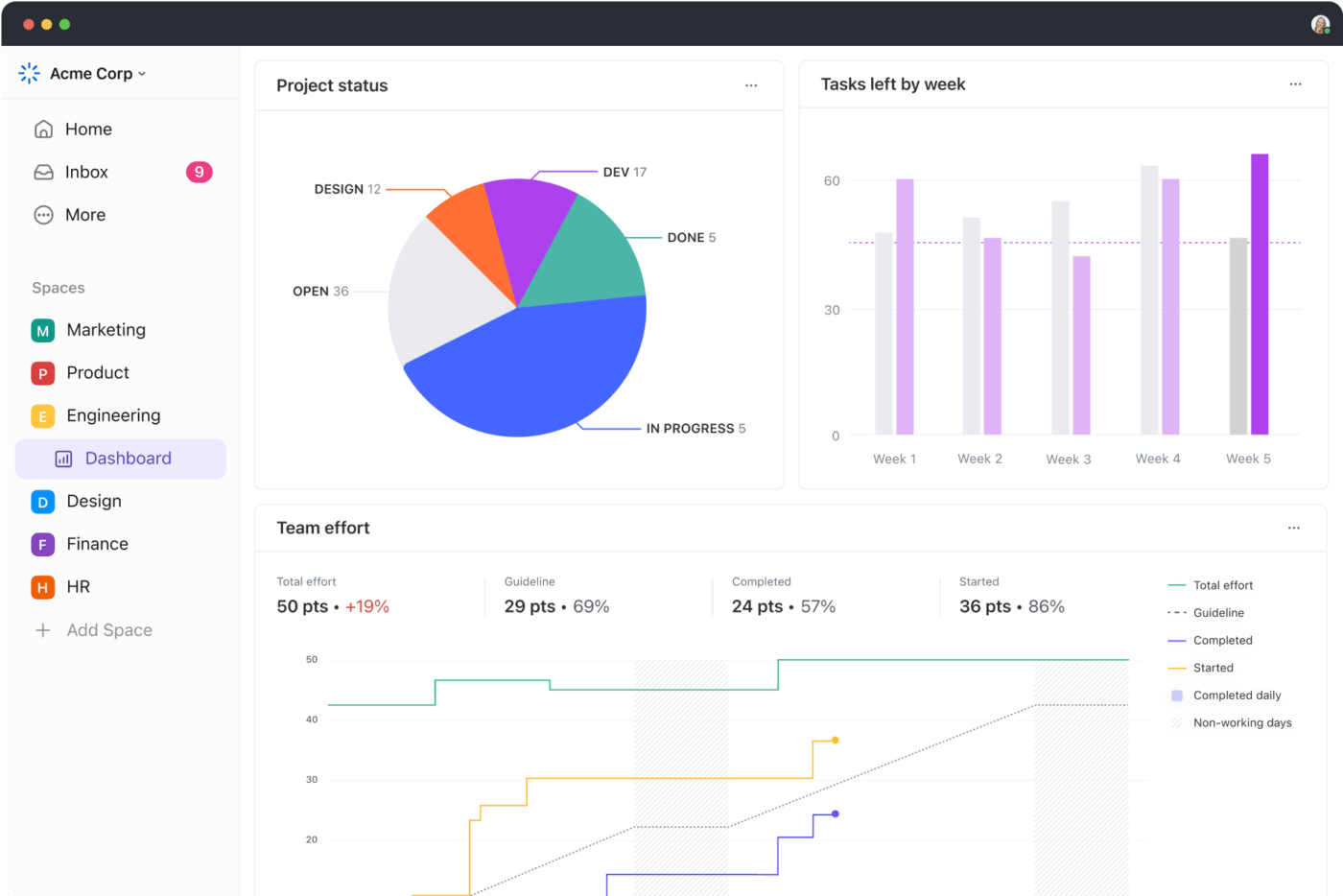
احصل على عرض شامل لحالات المشروع والمهام المتبقية في فريقك أو قسمك باستخدام لوحات المعلومات في ClickUp 3.0
على الرغم من شيوع الاختناقات، إلا أنها قد تتسبب في آثار كارثية لمديري المشاريع والشركة ككل. نظرًا لأن الاختناقات تقترن بتأخير الجداول الزمنية وزيادة التكاليف، فإنها تتسبب في تأثير الدومينو، مما يؤدي إلى عملاء ساخطين وميزانيات مكلفة وخطط تسويق ملغاة وأعضاء فريق محبطين.
عواقب الاختناقات في عملياتك
يمكن لعنق الزجاجة أن يعيث فسادًا في مشروعك (وفي الوقت المناسب، في شركتك بأكملها). في حين أن الاختناقات تختلف تبعًا لحجم خطة مشروعك الأصلية ونطاقها وجدولها الزمني، إلا أن هناك بعض العواقب العامة التي يجب أن تكون على دراية بها.
تفويت المواعيد النهائية
إذا كان هناك الكثير من العمل الذي يجب إنجازه، ولم يكن هناك عدد كافٍ من الأشخاص و/أو العمليات للتعامل معه، يصبح الوصول إلى الموعد النهائي للمشروع شبه مستحيل. على سبيل المثال، عندما تحدث اختناقات في عملية التصنيع، يمكن أن تؤخر خط الإنتاج بأكمله. وهذا بدوره يؤخر إطلاق المنتج النهائي.
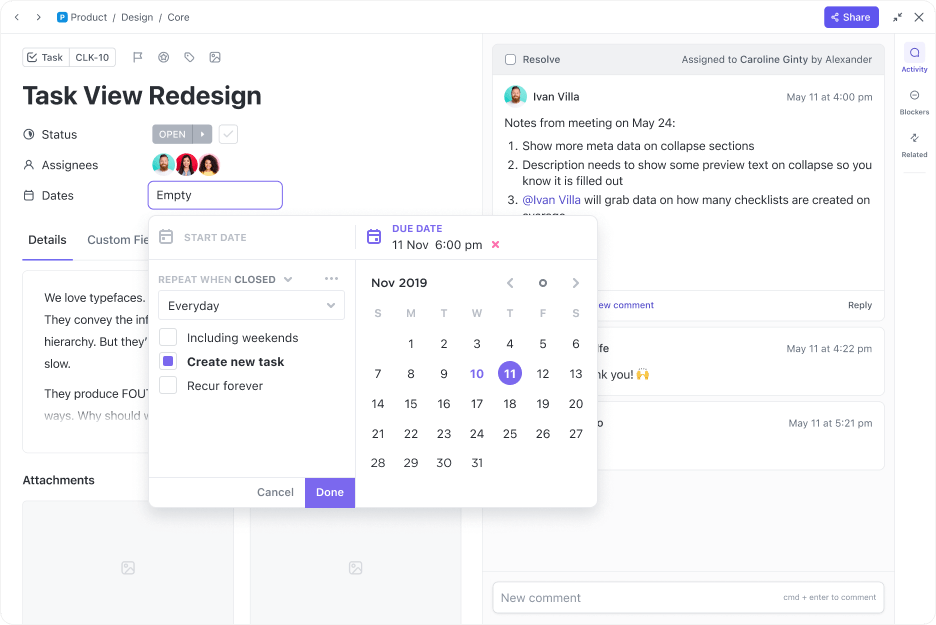
تعيين تواريخ البدء وتاريخ الاستحقاق بسهولة وسرعة داخل مهمة أو استخدام الإعدادات الشرطية لتكرار التواريخ أو إنشاء مهمة جديدة بعد الانتهاء
في إدارة المشاريع، يمكن أن تتسبب المواعيد النهائية الفائتة أو المهام المعاد تعيينها في فترات انتظار طويلة بين أعضاء الفريق. إذا تأخر أحد الموظفين في تسليم تقرير، يجب على مشرفه تأجيل مراجعته، مما يمنع فريق التصميم الجرافيكي من بدء العمل في الوقت المحدد. والنتيجة؟ إما أن يكون هناك اندفاع جنوني حتى النهاية، أو تسليم التقرير متأخرًا إلى العميل النهائي.
تجاوز الميزانية
تعد مواجهة الاختناقات إحدى أسهل الطرق لتجاوز الميزانية. على سبيل المثال، إذا كان لديك اختناقات في سلسلة التوريد الخاصة بك، فستحتاج إلى الحصول على مصدر من بائعين مختلفين أو تقديم طلب مستعجل. يؤدي ذلك إلى زيادة تكلفة المواد الخام بسرعة، مما يؤدي إلى زيادة إجمالي الإنتاج عن الميزانية.
غالبًا ما يجد مديرو المشاريع أن نفقاتهم العامة ترتفع بعد حدوث اختناق. إذا تعرض المشروع لوقت تعطل غير متوقع - مما يؤدي إلى تأخير المشروع - فقد تضطر الشركة إلى دفع أجور الموظفين لوقت إضافي لإنهاء المشروع في الموعد المحدد. أو قد يضطرون إلى توظيف عمال موسميين أو مقاولين للمساعدة في تخفيف عبء العمل.
ارتفاع معدل دوران الموظفين
لا أحد يرغب في العمل في حالة مستمرة من التوتر وسوء التواصل وإعادة تعيين مواعيد الاستحقاق. إذا كانت اختناقات المشروع تجعل أعضاء الفريق يعملون بأقصى طاقتهم، فقد يؤدي ذلك بسرعة إلى الإحباط والإرهاق.
وفقًا لـ تقرير غالوب عن حالة القوى العاملة 2023 الصادر عن مؤسسة غالوب أن ما يقرب من نصف العاملين (44%) يشعرون بالتوتر بشكل يومي. وهذا يؤدي إلى ارتفاع معدل دوران الموظفين، وهو ما قد يكون السبب في أن 51% من الموظفين يبحثون بنشاط عن وظيفة أخرى. الدرس المستفاد: إذا كنت ترغب في الاحتفاظ بأفضل المواهب، فقم بإيقاف الاختناقات قبل حدوثها، وبالتالي تقليل التأخر في العمل ليلاً، أو إعادة تعيين المهام، أو المشاريع المشوشة للموظفين.
علاقات متوترة مع البائعين
إن مواجهة الاختناقات الشائعة خلال عملية الإنتاج يمكن أن تشوه علاقتك مع الموردين أو البائعين. على سبيل المثال، على الرغم من أن بعض الطلبات الإضافية قليلة، إلا أن الطلبات المستمرة في اللحظة الأخيرة يمكن أن تصبح متعبة بسرعة. وبالإضافة إلى ذلك، إذا تسببت الاختناقات في تفويتك للمدفوعات، فقد تجد نفسك مدرجًا في القائمة السوداء من مورد موثوق به.
إضعاف العلاقات مع العملاء
تهدد الاختناقات الإنتاج الإجمالي، مما قد يؤدي إلى توتر - أو إنهاء - العلاقات مع العملاء. إذا فوّت فريقك المواعيد النهائية أو أعاد جدولة الاجتماعات أو قدم عملاً دون المستوى، فقد يطردك العملاء كمزود. وهذا يضر بأرباحك النهائية ويضر بسمعتك، مما قد يمنعك من الحصول على عقود مستقبلية.
خطوات عملية لتحديد وإدارة عوائق العمل
هل تشك في أن الاختناقات تهدد عملك؟ اتبع الخطوات أدناه لإجراء تحليل للاختناقات في سير عمل مشروعك. 🔍
1. افهم عنق الزجاجة الخاص بك
الخطوة الأولى لتخفيف عنق الزجاجة؟ فهم المشكلة التي تواجهها.
عندما يتعلق الأمر بإدارة المشاريع، هناك سببان للاختناقات:
- الاختناقات المستندة إلى الأنظمة الاختناقات المستندة إلى الأنظمة: الاختناقات المستندة إلى الأنظمة أو اختناقات العمليات تعني عادةً أنك لا تملك العمليات أو البرامج أو البنية التحتية المناسبة للتعامل مععبء العمل الحالي. ربما ليس لديك برنامج إدارة المشروع المناسب، أو إعداد خط التجميع، أو أتمتة سير العمل لمواكبة طلبات العملاء
- الاختناقات القائمة على الأشخاص: عادةً ما تعني الاختناقات القائمة على الأشخاص أنه ليس لديك عدد كافٍ من الأشخاص - أو ربما الأشخاص المناسبين - لمواكبة متطلبات المشروع. قد يعني هذا أنك بحاجة إلى توظيف عمال موسميين، أو توظيف عامل أقدم، أو العثور على زميل يتمتع بمجموعة مهارات فريدة من نوعها
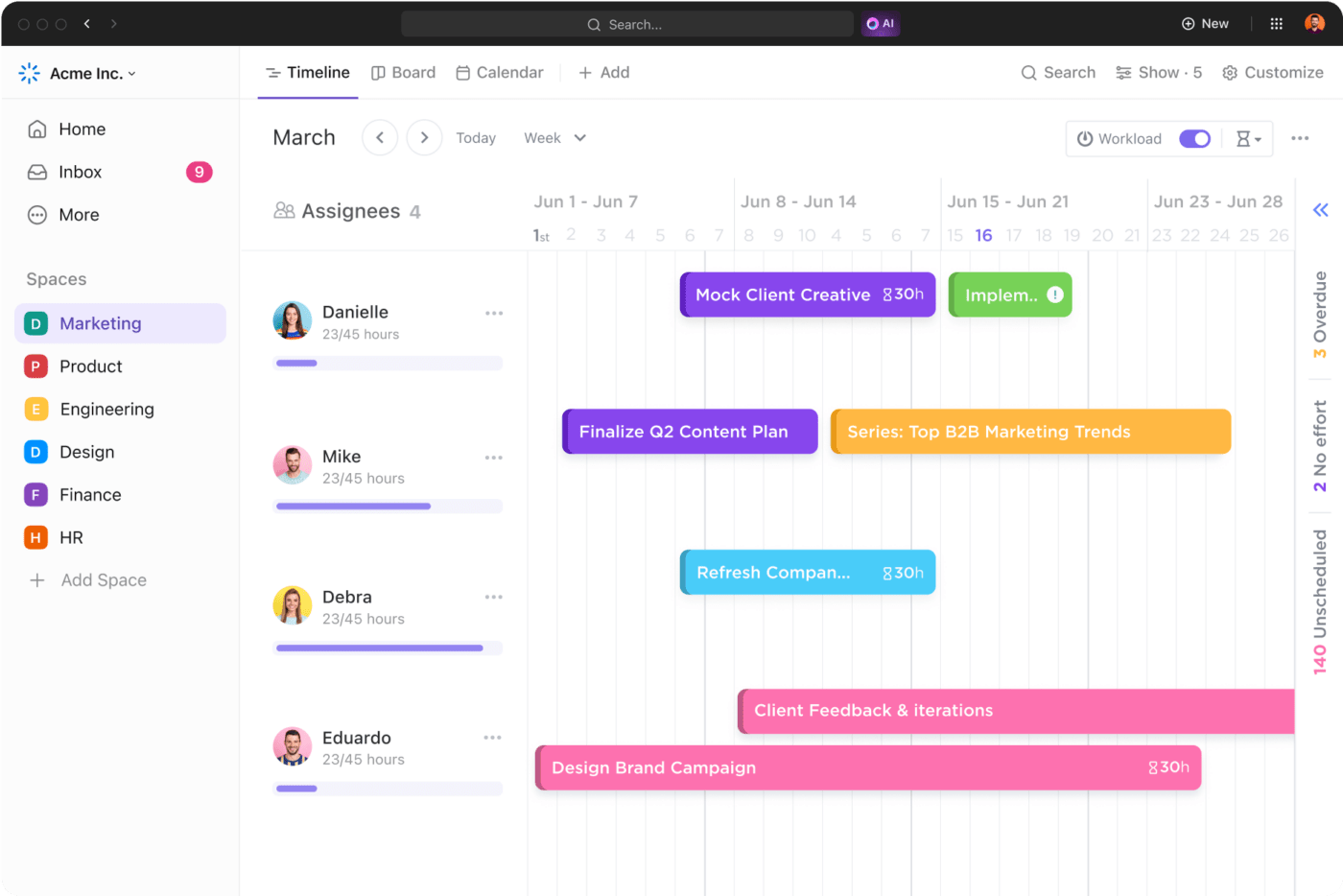
قارن أعباء عمل الفريق بصريًا وتتبع التقدم المحرز باستخدام طريقة عرض ClickUp Timeline
يمكن أن يساعدك فهم المشكلة في سير عملك على حل المشكلة، سواء كان ذلك يعني تعيين أعضاء جدد في الفريق، أو تحسين عمليات العمل، أو ترقية برنامجك.
2. رسم خريطة لعملياتك تخطيط العمليات يمنحك نظرة عامة على تدفق عملك على مستوى 500 قدم. يمكنك عرض كل خطوة في خطة مشروعك، وفهم المهام التي تم إنجازها في الوقت المحدد والمهام التي تسببت في تراكم العمل.
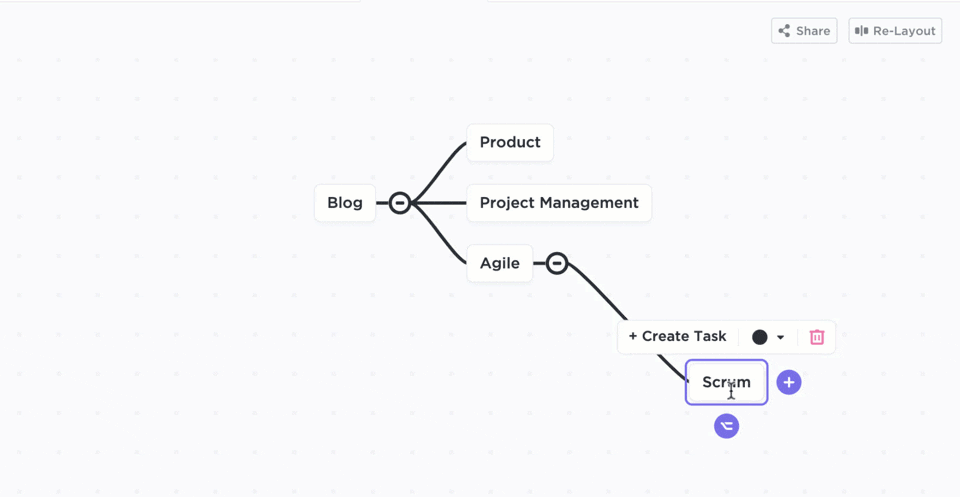
داخل الخرائط الذهنية في ClickUp، يمكنك بسهولة إعادة ترتيب العُقد بناءً على بنيتها الهرمية
من خلال رسم خريطة لمشروعك بأكمله - عادةً من خلال مخطط انسيابي أو أداة أخرى - يمكنك تحديد نقاط الخلاف في جدولك الزمني. من هناك، يمكنك تحليل المقاييس لتحديد أماكن الاختناقات.
3. تحدث إلى فريقك
بالتأكيد، الأرقام لا تكذب أبدًا - لكنها أيضًا لا تروي دائمًا القصة كاملة. اجمع جميع أصحاب المصلحة معًا، بدءًا من الإدارة العليا إلى الشركاء، واسألهم عن المهام الأكثر استهلاكًا للوقت أو التي غالبًا ما تضيع في خلط الأوراق.
من خلال إجراء محادثة صريحة وصادقة مع فريقك، يمكنك معرفة من هو الأكثر إرهاقًا، وسبب حدوث الانخفاض في التواصل، ومن يمكنه تقديم يد المساعدة.
4. قم بإنشاء خطة للتحسين المستمر خطة
بمجرد أن تحدد الاختناقات في فريقك خطط المشروع فقد حان وقت التعديل. حدد الأماكن التي يمكنك فيها إزالة أوجه القصور والتكرار أو موازنة عبء العمل في جميع أنحاء فريقك. يمكن أن يؤدي تنفيذ خطة التحسين المستمر إلى رفع الروح المعنوية للفريق، والحفاظ على المشاريع في الموعد المحدد والميزانية، وتعزيز العلاقات مع العملاء والبائعين.
عنق الزجاجة طرق الوقاية: 10 طرق للبقاء على المسار الصحيح
هل تتطلع إلى التخفيف من الاختناقات في إدارة المشاريع؟ تجد أدناه 10 استراتيجيات لإبقاء خطة مشروعك على المسار الصحيح - و أدوات إدارة عبء العمل التي تحتاجها لتحقيق ذلك 👏
1. قم بإنشاء تمثيل مرئي لسير العمل الخاص بك
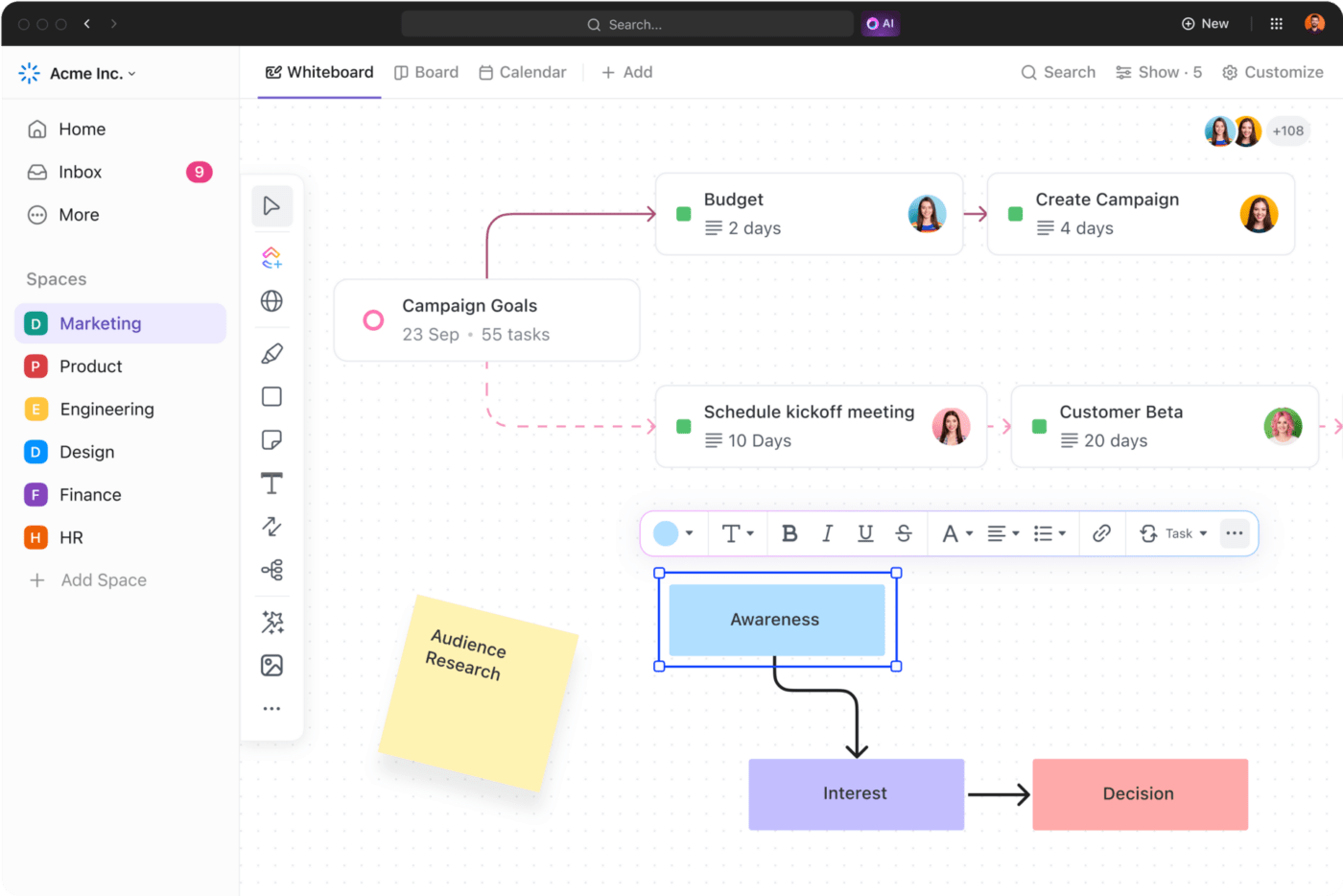
قم بالعصف الذهني أو وضع الاستراتيجيات أو رسم سير العمل باستخدام سبورة ClickUp Whiteboards التعاونية المرئية
أفضل طريقة للتخلص من الاختناقات هي إنشاء صورة مرئية لكل خطوة في خطة مشروعك. استخدم ClickUp Whiteboard لرسم سير عمل كل مشروع. من هناك، يمكن لأعضاء الفريق تدوين الملاحظات وتحديد نقاط الازدحام أو حتى رسم سير عمل بديل.
2. أتمتة المهام المتكررة
إذا كان فريقك يجد نفسه باستمرار يعمل بقدرة محدودة، فساعد في تخفيف العبء عن طريق أتمتة المهام المتكررة.

عرض الأتمتة النشطة وغير النشطة وإدارتها بسرعة عبر المساحات مع تحديثات المستخدم وأوصافها
مع أتمتة ClickUp يمكنك الاختيار من بين أكثر من 100 عملية أتمتة لتبسيط سير العمل والمهام الروتينية وعمليات تسليم المشروع. بالإضافة إلى ذلك، يمكنك تعيين المهام تلقائيًا أو إضافة تعليقات أو تحديث الحالات لمنع الاختناقات قبل حدوثها. يمكن أن يساعد القيام بذلك فريقك التركيز على الأولويات القصوى والحفاظ على سير مشروعك بسلاسة.
3. تنفيذ تخطيط السعة تخطيط السعة يتضمن تقدير الاحتياجات من الموارد اللازمة لإكمال مشروع معين (أي الأشخاص والوقت والأدوات اللازمة لإنجاز الأمور). يُعد تخطيط السعة جزءًا أساسيًا من الإدارة السليمة للعمليات، وهو عبارة عن معادلة العرض مقابل الطلب، حيث يتم حساب عدد الموارد التي تحتاجها وعدد الموارد التي يجب أن تقدمها.
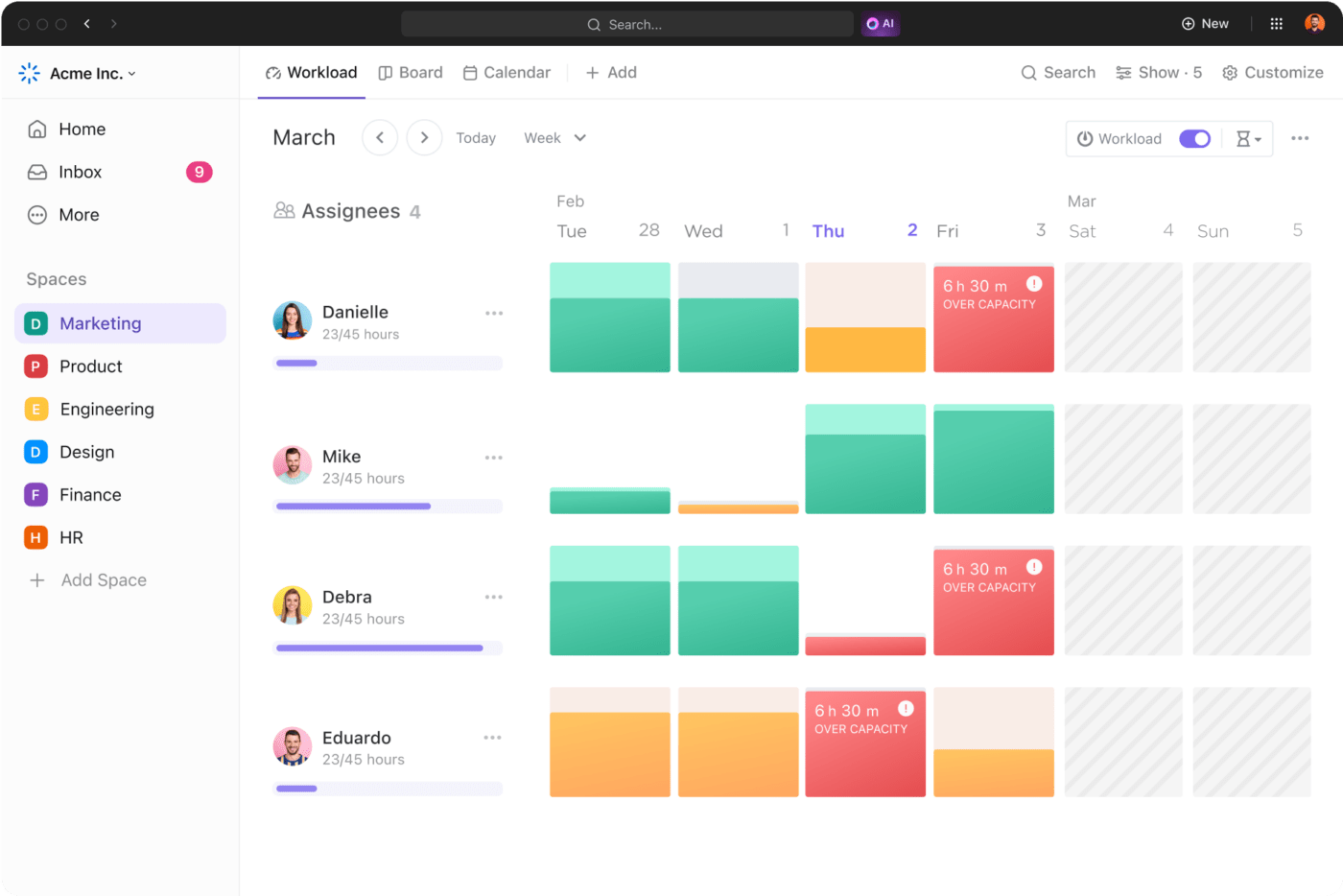
اطلع على أعباء عمل الفريق في لمحة سريعة لتفويض المهام أو إعادة تعيينها بشكل أفضل وفهم بسرعة من هو أقل أو أكثر من طاقته
لحسن الحظ عرض عبء العمل الخاص بـ ClickUp يجعل تخطيط السعة أمرًا سهلاً، حيث يمنحك تصورًا مرئيًا عن حجم العمل المفوض لكل عضو من أعضاء الفريق. من هناك، يمكنك الحصول على تصور لقدرة كل عضو من أعضاء الفريق فيما يتعلق بعبء العمل الحالي.
4. إنشاء مخطط جانت
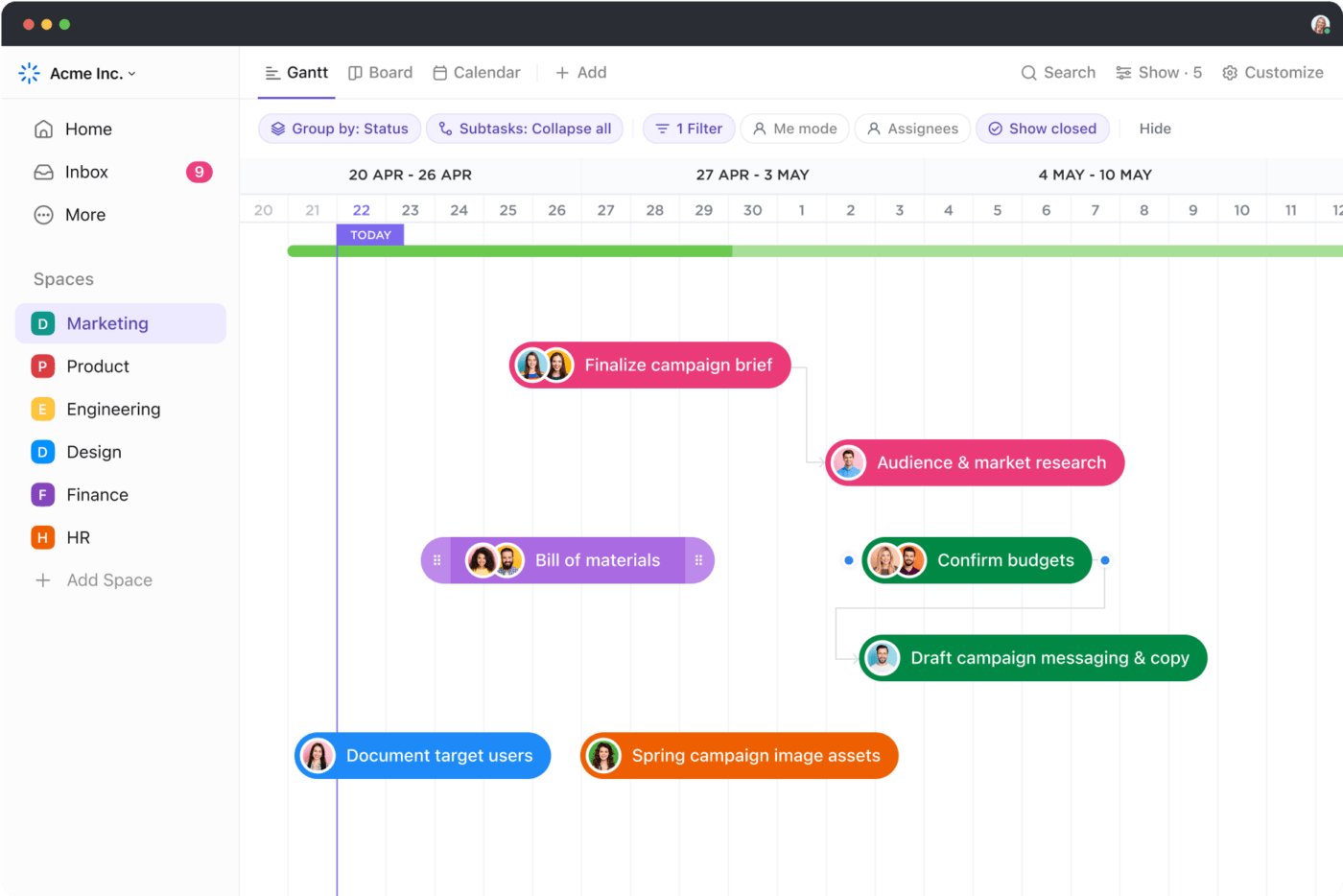
قم بتجميع المهام أو تصفيتها أو إخفائها في مخططات جانت ClickUp 3.0 لتتبع سير العمل وربطه عبر جميع أعمالك مخططات جانت هي أدوات مذهلة تمنحك صورة مرئية لجميع الجداول الزمنية للمشروع لتحقيق أقصى قدر من الإنتاجية. مع مخططات جانت الخاصة ب ClickUp يمكنك تتبع تقدم المشروع وإدارة المواعيد النهائية واكتشاف الاختناقات المحتملة. بالإضافة إلى ذلك، يمكنك إنشاء طرق عرض متتالية لتحديد أولويات المهام المهمة بسهولة.
5. فهم المهام التابعة
أحد الأسباب الجذرية للاختناقات هي المهام التابعة (أي المهام التي يمكن أن تعيق أو تمنع مهمة أخرى من البدء). مع انقر فوق التبعيات يمكنك إنشاء علاقات بين المهام أو المستندات. ما عليك سوى إنشاء تبعيات "حظر" أو "انتظار" حتى يفهم فريقك دائمًا أفضل ترتيب للعمليات.
6. الاستفادة من قالب تحسين العملية
يساعد تحسين العملية على تحديد كفاءة الأنظمة والعمليات داخل مؤسستك. مع قالب تحسين العملية ، يمكنك إنشاء خطة متزامنة لإجراء تغييرات على مشروعك.
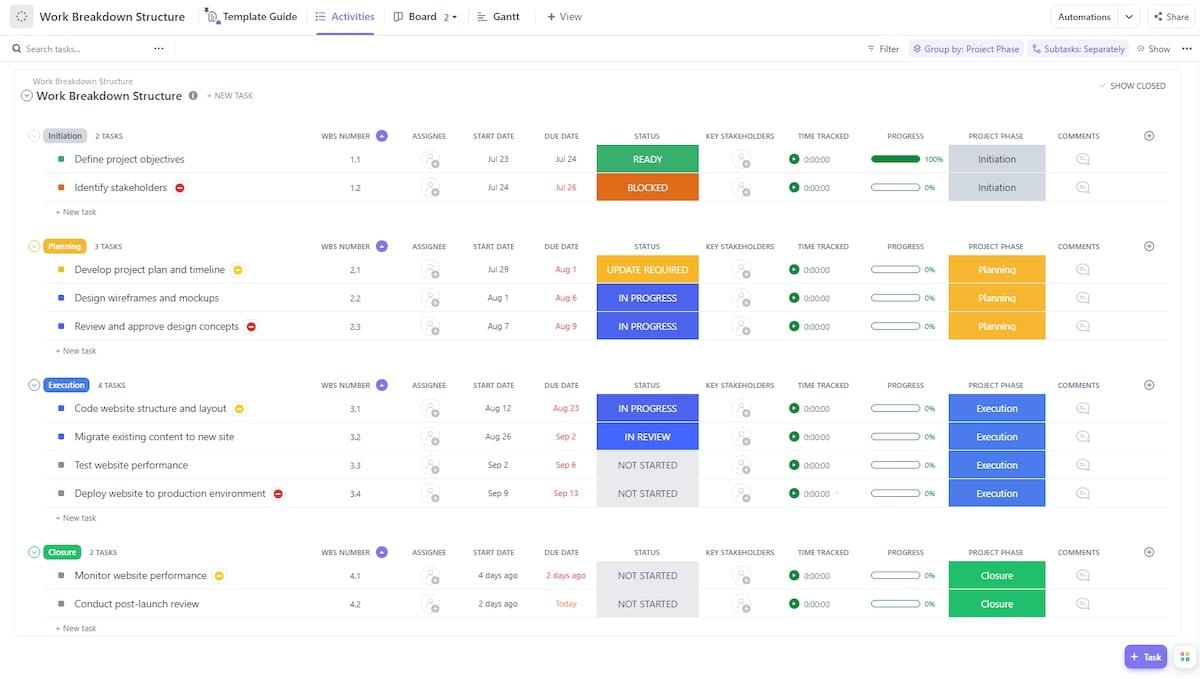
قم بتخصيص مراحل خاصة بك أو استخدم الفئات الجاهزة في قالب هيكل تقسيم العمل للبقاء على رأس مهام تحسين العملية
/ctaBtn/الأخضر https://app.clickup.com/signup?template=t-182104300 قم بتنزيل هذا القالب /%ctaBtnTn/
لحسن الحظ، يأتي ClickUp مع قوالب متعددة حيث يمكنك إضافة حقول مخصصة، أو تخصيص طريقة العرض الخاصة بك، أو التعاون مع الزملاء لوضع خطتك موضع التنفيذ بسهولة.
7. تقسيم المشاريع إلى مراحل رئيسية
قد تكون المشاريع التي تمتد لعدة أسابيع - إن لم يكن لأشهر أو سنوات - مخيفة. ولمنع مشروع كبير من الانهيار، تأكد من تقسيم المشاريع إلى أجزاء أصغر.
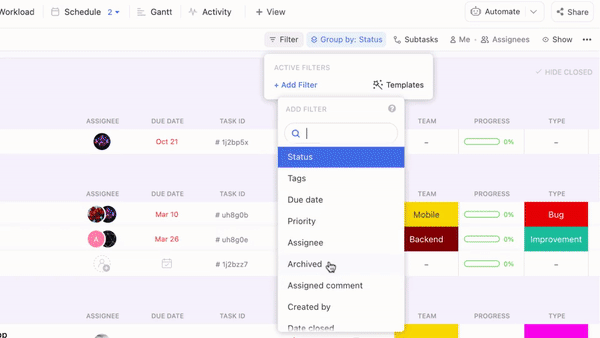
حدد النقاط المهمة في مشروعك بسهولة باستخدام معالم ClickUp Milestones واستخدم الرموز الماسية العريضة للحفاظ على تركيز الجميع على الأهداف الرئيسية
التنفيذ معالم المشروع تقسيم خطتك إلى مراحل مختلفة (على سبيل المثال، مرحلة التصميم أو مرحلة التطوير)، وبالتالي إبقاء فريقك على المسار الصحيح. استفد من مخطط المعالم للحصول على نظرة عامة عالية المستوى لكل مرحلة من مراحل مشروعك. ثم استخدم انقر فوق الحالات المخصصة وظيفة لإبقاء فريقك على اطلاع دائم بآخر المستجدات أثناء عملك على كل مرحلة من المراحل.
8. تحدث مباشرةً إلى أعضاء الفريق
كما ذكرنا أعلاه، في بعض الأحيان لا ترسم البيانات صورة واضحة - ولهذا السبب تحتاج إلى التحدث مباشرةً إلى أعضاء الفريق عند تحسين خطط المشروع.
إذا كنت تتطلع إلى منع الاختناقات، فاطلب من أعضاء الفريق الحصول على تعليقاتهم حول ما نجح (وما لم ينجح) في المشاريع السابقة. من خلال ClickUp، يمكنك استضافة جلسة عصف ذهني أو إرسال استبيان إلى جميع الأطراف ذات الصلة. من هناك، يمكنك أن تفهم ما إذا كان عنق الزجاجة ناتجًا عن نقص الموارد، أو نقص الموظفين، أو لأنك لم يكن لديك أدوات إدارة المشروع .
9. تنفيذ تتبع الوقت
![]()
عرض الوقت المتعقب عبر المهام والمواقع لإلقاء نظرة مبسطة على تقدم الفريق بشكل عام
أحد أسباب خروج المشاريع عن مسارها هو أن الفرق تقلل من تقدير الوقت المستغرق لإكمال مهمة معينة. للتأكد من أن جميع جداول المشروع دقيقة، والاستفادة من تتبع وقت النقر فوق تتبع الوقت . يمكن لأعضاء الفريق تسجيل الوقت بسهولة من أي جهاز، وتعديل الإدخالات، وإضافة ملاحظات إلى سجلات الوقت لإنشاء تقديرات أفضل للوقت في المستقبل.
10. توحيد اتصالات الفريق
لا تخرج المشاريع دائمًا عن المسار الصحيح لأن فريقك لا يتواصل. وبدلاً من ذلك، قد تخرج عن مسارها الصحيح لأنها تتواصل في الأماكن الخاطئة

اجمع اتصالات الفريق معًا في مساحة واحدة مع ClickUp Chat وشارك التحديثات واربط الموارد وتعاون دون عناء
إذا اضطر فريقك إلى فرز رسائل البريد الإلكتروني والرسائل النصية وقنوات Slack للعثور على آخر تحديثات مشروع ما، فهذا لا يفيدك في شيء. لحسن الحظ، مع عرض ClickUp Chat ، يمكنك دمج جميع المحادثات داخل برنامج إدارة المشروع الخاص بك، وبالتالي منع الاختناقات قبل حدوثها.
## منع الاختناقات قبل حدوثها مع ClickUp
يحدث عنق الزجاجة في إدارة المشاريع عندما يكون لديك الكثير من العمل وموارد قليلة جدًا للتعامل معه. ويؤدي هذا الازدحام إلى تراكم العمل، مما يؤدي إلى تجاوز خطط المشروع للميزانية أو تجاوز الجدول الزمني المخصص له.
لحسن الحظ، لدى ClickUp أدوات إدارة المشروع لتحديد الاختناقات وإبقاء خططك على المسار الصحيح. باستخدام ClickUp، يمكنك تعيين المهام، وإبداء التعليقات، وتعيين معالم المشروع، وتخصيص طرق العرض لمنع الاختناقات قبل حدوثها. بالإضافة إلى ذلك، يمكنك أتمتة المهام المتكررة، ودمج ClickUp مع مئات الأنظمة الأخرى، والاستفادة من آلاف القوالب لمساعدة فريقك على الالتزام بالجدول الزمني.
ابدأ في تحديد الاختناقات في أسرع وقت عندما جرّب ClickUp اليوم . 🙌

